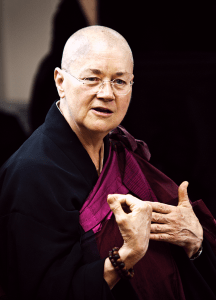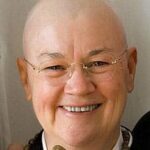The walls that separate us seem to be falling away. These days, many of the old constructions and categories of identity are dissolving. We are realizing there is no such thing as “race” or binary gender or “normal” sexual preference.
It feels like a moment of possibility and joy. But while we may know this intellectually, many Buddhists have not yet let it penetrate to our hearts. There is still suffering, withdrawal, and tentativeness in relation to identity, practice, and community.
When we first begin Buddhist practice, we bring with us our own suffering, traumas, and confusion, often around our identity. For whatever reason, we have ended up on the shores of a Buddhist refuge. We are seeking relief, a way out of the suffering, no matter what we think the causes of our distress are.
We may feel that the world doesn’t see us as we truly are, and maybe we don’t even see ourselves very clearly. We may feel unacknowledged, incomplete, and forced to fit into a mold that is not what we feel inside. Perhaps we are alienated from our family, our old friends, maybe even from ourselves. We may fear for our personal safety or our reputation. We may be angry toward the others who refuse to recognize and respect us. We feel separate.
While many people experience this to one degree or another, oppressed and often invisible minorities—such as those of us with non-conforming sexual and gender orientations—can be especially vulnerable to these feelings.
If we are lucky, we encounter teachings that help us to heal, find our true selves, and free ourselves from roles and ideals that do not fit our real nature. We begin to break down fixed or received ideas about ourselves, our bodies, our relationships, and our potential. We realize that we have in some way accepted society’s definition of who we are or should be.
Through our Buddhist practice, we can let all that drop away. We begin to recognize not only our own intimate, personal self, but also two other aspects of the self—our porous, impermanent self, and our self that is part of all that is.
Let me share with you three teachings that have opened my understanding of this threefold aspect of the self—the personal self, the universal self, and the self who abides in both. These teachings, arising out of a koan, a sutra, and a precept, can help us realize the marvellous ineffability of the constantly shifting and insubstantial nature of self, liberating us from our fixed notions of identity and self-nature.
Senjo’s Soul: The Intimate Self

A Zen koan that takes on the problematic question of our self-identity on a personal level begins simply with a question.
Zen teacher Goso asked, “Senjo and her soul are separated—which is the true Senjo?” The question is based on a beautiful old Chinese ghost story.
Once, in a village by a river, a girl and a boy, second cousins, grew up together as inseparable companions. They were so close that the girl’s father once joked that they seemed married already. Eventually, they did fall in love. However, the girl’s father announced that she was to marry a different man.
The girl, Senjo, and her sweetheart, Ochu, were devastated, and Ochu was so upset that he decided to take his boat and leave the village. Just as he began to sail down the river, he saw a shadowy figure standing on the riverbank. Senjo stepped into the boat and they escaped down river together.
Five years passed. They had two children and were very happy, except that from time to time Senjo would burst into tears because she missed her family. They decided to return, and when they arrived home, Ochu went up to Senjo’s house to ask forgiveness for leaving with her. Her father seemed surprised, and said, “What? From the day you left, Senjo has been upstairs lying on her bed, looking so sad, and she’s never said a word.”
Just then, Senjo from the boat arrived at the door, and suddenly the Senjo from upstairs appeared, smiling. The two Senjos looked at one another, smiled, and walked right into one another. Instantly, they became one.
So the question is: “Senjo and her soul are separated. Which is the true one?” Senjo might have answered, “I’m not sure which is the real me—the one who married Ochu or the one who stayed with my family and lay sick in bed.”
Your question might be: “Which is the true me, the one trying to fit into this world or the one who is shrinking and fearful, hiding and unexpressed?” Are they one or two?
This story dramatically shows the bringing to life of cast-off parts of the self and the healing gained through integration. When we simply allow and acknowledge the deeply felt personal aspect of the self, we can heal.
This is the interior “self-intimate” piece of who we are. It cannot be ignored. It is the deepest personal experience of who we are, and when we take care of that lost self, like Senjo lying in her bed at home, then we are no longer cut off from our experience and what often drives our daily conduct. Without integrating that self, without that wholeness, we live on the surface, on automatic, not drawing on the wellspring of our life. Goso’s question, “Who is the real Senjo?” can only be answered when we connect to all of our personal self.
And yet, of course, this is not all of who we are.
The Goddess’ Body: The Universal Self
There are innumerable Buddhist teachings reminding us that our self is not fixed. It is a flowing and temporary process of the skandhas—body, perception, conception, volition, and consciousness. Moment to moment, always changing, they form and re-form who we are, what we call our “self.”
If we integrate this understanding, then our sense of ourselves—how we think of ourselves and our identity—does not imprison us, but frees us. This is so important these days when fixed sexual, gender, and racial categories are being challenged.
There is a marvelous teaching in the Vimalakirti Sutra on this matter. The scene is Vimalakirti’s sickroom, which has miraculously expanded to accommodate numerous beings (even us!). Manjusri and Vimalakirti have been discussing the nature of the self—how it is impermanent and lacks solidity, yet gives and receives compassion.
A goddess appears and debates Shariputra about the nature of language and identity. At a certain point, Shariputra becomes agitated with the goddess’s skill in debate and, indirectly asserting his male privilege, says in exasperation, “Why don’t you change out of this female body?”
The goddess replies, “For the past twelve years I have been trying to take on the female form, but in the end with no success. What is there to change? If a magician were to conjure up a phantom woman, would it be reasonable to ask her why she didn’t change out of her female body?”
“No,” Shariputra says. “Phantoms have no fixed form, so what would there be to change?”
The goddess replies, “All things are just the same—they have no fixed form. So why ask why I don’t change out of my female form?”
Then the goddess employs her supernatural powers to change Shariputra into a goddess like herself, while she takes Shariputra’s form. Then she asks, “Why don’t you change out of this female body?”
Shariputra, now in the form of a goddess, says, “I don’t know why I have suddenly changed and taken on this female body!”
The goddess replies, “Shariputra, if you can change out of this female body, then all women can change likewise. Shariputra, who is not a woman, appears in a woman’s body. And the same is true for all women—though they appear in women’s bodies, they are not ‘women.’ Therefore the Buddha teaches that all phenomena are neither male nor female.”
What a radical and liberating teaching! On the one hand, there is the internal self that we have hidden and that cries out to be heard, just like Senjo’s ghostly self. That self is recognized and healed by our awareness and attention.
On the other hand, there is the aspect of our self that is neither male nor female, that has no intrinsic nature. It is emptiness itself—a non-substantial, impermanent flow, where there is no “is” and “is-not,” where there is no boundary, and all energy and life flows in and out of itself. That is the wondrous aspect of the self, free and responsive.
Three Pure Precepts: The Self in the World
But how are these two aspects of the self—the demands of our ordinary self and our extraordinary self—reconciled in our day-to-day life? What about our actual conduct in this life?
For me, the most helpful teaching in this regard derives from the early teachings on morality. These are the three pure precepts, handed down over many generations and now also known as the Zen Peacemaker three tenets. They are:
Not Knowing.
Bearing Witness.
Taking Action.
Not knowing, breath by breath, I enter the mystery of life without any fixed ideas of yes or no, this or that. Who am I really? I encounter my sense of self and identity as a possibility. It is what is arising right now, having nothing to do with what I’ve been told or what I’ve thought up until now.
Freely, I can rest in the cloud of unknowing. Here anything is possible. Our perspective has no point, but all points; no “way,” but all ways. We are not bound by our old ideas of self. When we approach life from this position, we drop all that we know and we are often surprised to find a new vibrant reality. In each moment, can I allow the possibility of what is arising now, not yesterday or tomorrow?
Bearing witness, on the other hand, brings in a multiplicity of perspectives. Anchored in not knowing, we see with new eyes, taking no sides but witnessing the joy and suffering around us and in us. This too is who we are.
To bear witness is to listen without any preconceptions, ideas, or judgments. It is to listen with the whole heart and mind that has experienced the depth of not knowing. This is the listening of Avalokitesvara, the bodhisattva who hears the cries of the world. It is listening without judging or reaction. It is listening with sincerity and openheartedness.
We listen so deeply we can hear what self and other are saying, and also what is unsaid. Just by listening like this we relieve much suffering. We are able to offer empathy, compassion, and wisdom to all the selves we encounter—inside and outside, self and other.
Taking action then is as natural as Avalokitesvara’s raising an arm to save a wandering child. It is simply a genuine response to what is needed. Based on the wisdom of not knowing and bearing witness, we act spontaneously, holistically, and compassionately.
In a way, we can see this as the task of liberating our self so that we can fully appreciate this life, joyfully express ourselves, and serve the world. What, then, is this self? There is the self that integrates itself, as in Senjo’s koan; the self that flows with the changing tides of reality, as the goddess does in the sutra; and the self that approaches ordinary life with the wisdom of not knowing, bearing witness, and taking action.
These three teachings have helped me resolve my own understanding of the self and how it functions in the world. Instead of shame and hiding, instead of anger and frustration, I’ve found solace and strength. In this way, I can be available to the self that is calling through me from the Self that is all space and time.

